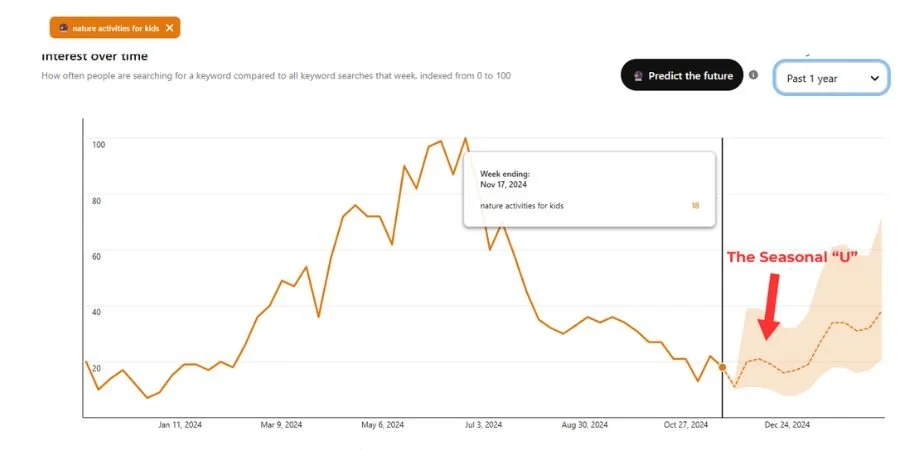The Seasonal “U” and You: Using the Pinterest Trend Tool
I’m writing this post during the last week of November. Every free minute that I have of late has been absorbed by planning for the holidays. I’ve been busy buying gifts, ordering cards, planning meals, organizing travel plans, decorating the house – outside and inside. This flurry of activity typically lasts until mid-December when life returns to its regular rhythm.
The same is true for Pinterest users at this time of year. Our beloved teachers, school librarians, and homeschooling parents are buzzing at the same pace I am, while somehow managing the educational needs of their classrooms and kids. The Trends tool shows that currently they are coming to Pinterest in search of Thanksgiving recipes, Christmas tree ideas, and turkey disguise projects (Who would’ve known?). Trends also show that by the end of December, parents and educators will resume their Pinterest search activities in a more predictable way.
If you’ve noticed a dip in engagement on your non-seasonal pins lately, don’t worry—you’re not alone. This is part of what marketers call the Seasonal “U,” a predictable dip and rise in Pinterest activity tied to shifting search habits around the holidays. While these holiday search trends reflect the joy of the season, it’s hard on those of us who are marketing educationally sound material.
The good news? This dip is only temporary. For those of us producing high-quality, evergreen content, the Seasonal “U” is just a brief lull before activity picks up again. But don’t just take my word for it—let me show you exactly how this works with some examples below.
To illustrate the fall and rise of evergreen content on Pinterest, let’s have some fun with the Trend Tool, a feature that provides insights into trending topics, keywords, and interests on the platform. It allows users to explore what people are searching for and engaging with over time, offering data on seasonal trends, popular searches, and audience behaviors.
The Trend Tool is great for analyzing how specific keywords or topics perform over a selected time period, showcasing their popularity and seasonality. A really fun thing to do with the Trend Tool is to compare several search terms in efforts to observe patterns and trends over time – The Seasonal “U”!
For our purposes, let’s take a closer look at the search trend for the phrase “nature activities for kids”—a keyword we often rely on when optimizing nonfiction content about trees, oceans, weather, animal habitats, and conservation topics. The Trend Tool graph below provides a snapshot of how this term has performed over the past year.
Here’s how to read it: the solid orange line shows how “nature activities for kids” has trended historically, while the dashed lines and shaded area to the right represent Pinterest’s predictions for future growth. At the time of writing, we’re at a dip in the curve—a low point—but look closely. By mid-December, this topic is predicted to climb substantially.
This pattern, my friend, is an example of the Seasonal “U.” We’re currently in the valley, but the trend is poised to rise again soon. It’s a natural ebb and flow that’s a key part of planning content on Pinterest.
While we’re at it, let’s test something. Let’s compare several topics to see if there is a predictable Seasonal U pattern of some sort happening. Let’s try the phrases “math games,” “5th grade science fair projects ideas”, “kindergarten science experiments”, and “nature activities for kids” – all of which are subjects for evergreen content on the platform.
Take a look at the graphic below. Notice how the solid lines representing evergreen content seem to zigzag all over the place—it’s a bit chaotic, right? But here’s the cool part: all the dashed lines on the left dip around December 24 and then rise together in perfect synchronicity afterward. This, my friend, is the essence of the Seasonal "U" in action. The December dip marks the natural low point before interest steadily climbs, building momentum and surging upward as engagement increases. It’s a reliable pattern that shows us when to anticipate—and capitalize on—the rise.
As we’ve seen with the Seasonal "U," dips like this are temporary and simply part of the natural cycle on Pinterest. These moments may seem quiet, but they’re actually the perfect time to double down on your efforts. Use the dip as an opportunity to create and post high-quality, relevant content. When the "U" rises—and it always does—your content will be ready, indexed, and primed for success.
Remember, Pinterest is a long game. Growth takes patience and persistence, but the rewards are worth it. Your content has value, and it will gain traction as you stay consistent. Keep pinning, stay visible, and lean into the trends that align with your goals. Consider refreshing and repurposing older pins to match seasonal themes—it’s a smart way to keep your pin library working for you.
Finally, keep experimenting and learning. Every pin you post, every tweak you make, and every trend you embrace brings you closer to your audience. Trust the process, and don’t hesitate to explore new strategies. I’ll be here to guide you along the way with more tips and insights in future posts.
Stay consistent, stay creative, and remember—your content is resilient. The climb back up the "U" is coming, and your efforts will shine when it does. You’ve got this!
Pin Lit Marketing is the premier Pinterest strategist for books, blending literary insight with unmatched expertise in captivating young readers. Your new audience awaits! Sign up for a Fit Call today!









